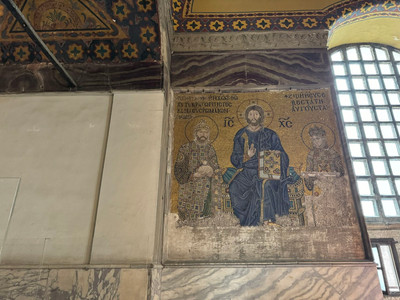For centuries, as a European I would have said: I have reached the Levant, or Asia Minor, or Anatolia. But, these days I just say “I’m in Türkiye now”. And more than any Occidental nomenclature, if there is one thing that shows abundant reminiscences to history, it is the Turkish flag.
几个世纪以来,作为一个欧洲人,我本会说:我到达了黎凡特、小亚细亚或安纳托利亚。但如今,我只会说“我现在在土耳其”。而且,比起任何西方的命名,如果有什么能充分展现对历史的追忆,那就是土耳其国旗。

It carries the well-known Islamic sign of Crescent and Star, legacy of the Ottoman Empire that ruled from 14th to 20th century. But, much deeper, it refers to a completely different concept of life, which I happen to believe goes beyond an Islamic symbolism, to touch upon alternative concepts of time, creation, worship, and gratitude in life.
它承载着众所周知的伊斯兰象征——新月和星星,这是从14世纪至20世纪统治的奥斯曼帝国的遗产。但更深层次地,它指向了一个完全不同的生活观念,我恰好相信这种观念超越了伊斯兰象征主义,触及了生活中关于时间、创造、崇拜和感恩的替代概念。
Maybe it even goes back to the very first sentences of the Old Testament, up to the moment when God said “Let there be Light”, the origin of stars and crescent, implying that all that comes after, cannot do without it. And that every day, and every month, reminds us to that simple fact. Apparently, with a little help of the Turkish flag and with it, the flag of a number of other Islamic countries.
或许这种象征甚至可以追溯到《旧约》最初的篇章,回到上帝宣布“要有光”的那一刻——星与月的诞生,意味着一切随之而来的存在都与此不可分离。而且每一天、每一个月都在提醒我们这个简单的事实。显然,这点从土耳其国旗,乃至其他许多伊斯兰国家的旗帜中,都能得到些许启示。
I am writing this in such essentialist wordings, as I came to realize what it means to start deviating from this simple truth while passing a little town that once witnessed two of the most important Councils in the history of Christianity, pinning down an orthodoxy that is shared even by Catholic, Eastern Orthodox, Protestant and other Christian Churches: Nicaea, today known as Iznik. A place where this deviation became substance of new dogma. While I go further East, across mountain ridges and dusty roads, it wasn’t left unnoticed that I crossed paths with a theological dispute that marked much of history since Constantine the Great and the acceptance of Christianity as State religion, adding power to synthesis.
我之所以用这样本质主义的语言来写下这些文字,是因为我在经过一个小镇时,逐渐意识到偏离这个简单的真理意味着什么。这个小镇曾见证了基督教历史上两次最重要的宗教会议,确立了一个连天主教、东正教、新教以及其他基督宗教教派都认同的正统教义:那就是尼西亚,今天称为伊兹尼克的地方。这里,偏离转化为了新教义的实质。当我继续向东越过山脊和尘土飞扬的道路时,我注意到自己的路线与一个神学争议相交叉,这争议自君士坦丁大帝以来标志了大部分历史,见证了基督教成为国教以及对合成权力的增强。
Both Councils of Nicaea (325 and 787 AD), the first and the last of seven Councils bridging about 450 years of early Middle Ages, where crucial in taking an alternative theological road to what was taught thus far in any Old Testament based thinking: the definition of what is Holy, defining Christ and the Holy Spirit of equal holy substance as God himself; and secondly the restoration of veneration of icons as a genuine act of devotion. Both moments mark a definitive departure of the much more basic spiritual traditions that came before, pre-empting the beginning of a Christian civilization that, with no exaggeration, has determined much of all antagonisms ever since. And hence, much of all violent showdowns that followed. What started in Nicaea as theological disputes, developed as clashes of civilizations, orientalisms and book burnings. And much worse.
尼西亚的两次大公会议(公元325年和787年),分别是早期中世纪大约450年历史中的首次与末次会议,它们在神学上选择了一条与旧约基础上迄今为止的教导截然不同的路径:首先,关于圣洁的定义,将基督和圣灵定位为与上帝自身同等圣洁的本质;其次,恢复对圣像崇拜作为一种真诚的敬仰行为。这两个历史节点明确地标志了从以往更为原始的精神传统中的断裂,并预示了基督教文明的起始——这种文明无疑深刻地影响了自那以后所有的敌对关系。因此,这也是随之而来的所有暴力冲突的根源。在尼西亚开始的神学争议,演变为文明的碰撞、东方情结以及书籍焚烧,乃至更为恶劣的事态。
The First Council of Nicaea, by adding Jesus and the Holy Spirit to the godly rostrum, gave final vindication to the Gospel, and hence the New Testament. It was good perhaps for the unity of Christianity, while providing a stick to wield all others. The Second Council of Nicaea defined the means of worship, which, perhaps at a slightly less fundamental level, divided as much as it synthesized, and lays at the root of any fights between so called true believers and heretics. It stipulated that an image could be as holy as the content of that image. Ever since, iconoclast could be considered dangerous fundamentalists.
第一次尼西亚大公会议将耶稣和圣灵引入了神圣之列,从而为福音书和新约提供了最终的证明。这对基督教的团结或许是有利的,尽管它也成为了打击异见者的武器。第二次尼西亚大公会议确定了崇拜的形式,这些形式虽然在根本层面上稍显温和,但同样引发了分歧与融合,并且成为了所谓的真信徒与异端之间斗争的根源。它明确了图像可以与其所表达的圣洁内容同等神圣。从此以后,反对圣像的行为就可以被看作是危险的原教旨主义。
There are many things to explore while going on a Journey to the East. There are plenty moments to enjoy the subtle shifts of cultural change. But sometimes it’s good to grasp the meaning of a place, whatever modest today, as a genuine turning point, as a new Beginning of History, splendid and bleak at once. This is to Iznik, to acknowledge its role in human history as the place of a great divide.
在东游记的旅途中,有许多东西值得探索。有无数瞬间可以细细品味文化变迁的细微差别。但有时,真正理解一个地方的意义很重要,不管它今天看起来多么不起眼,它都可能是一个真正的历史转折点,一次既辉煌又凄凉的历史新开端。这是对伊兹尼克的致敬,以认可它在人类历史中作为一大分界线的地位。
Journey to be continued...
and to follow the Journey by
Instagram:@Olebouman
Linkedin:@Olebouman
Facebook:@Olebouman
Linktree: https://linktr.ee/olebouman
YouTube:@JourneytotheEast-olebouman
Weibo:@Olebouman




Comments